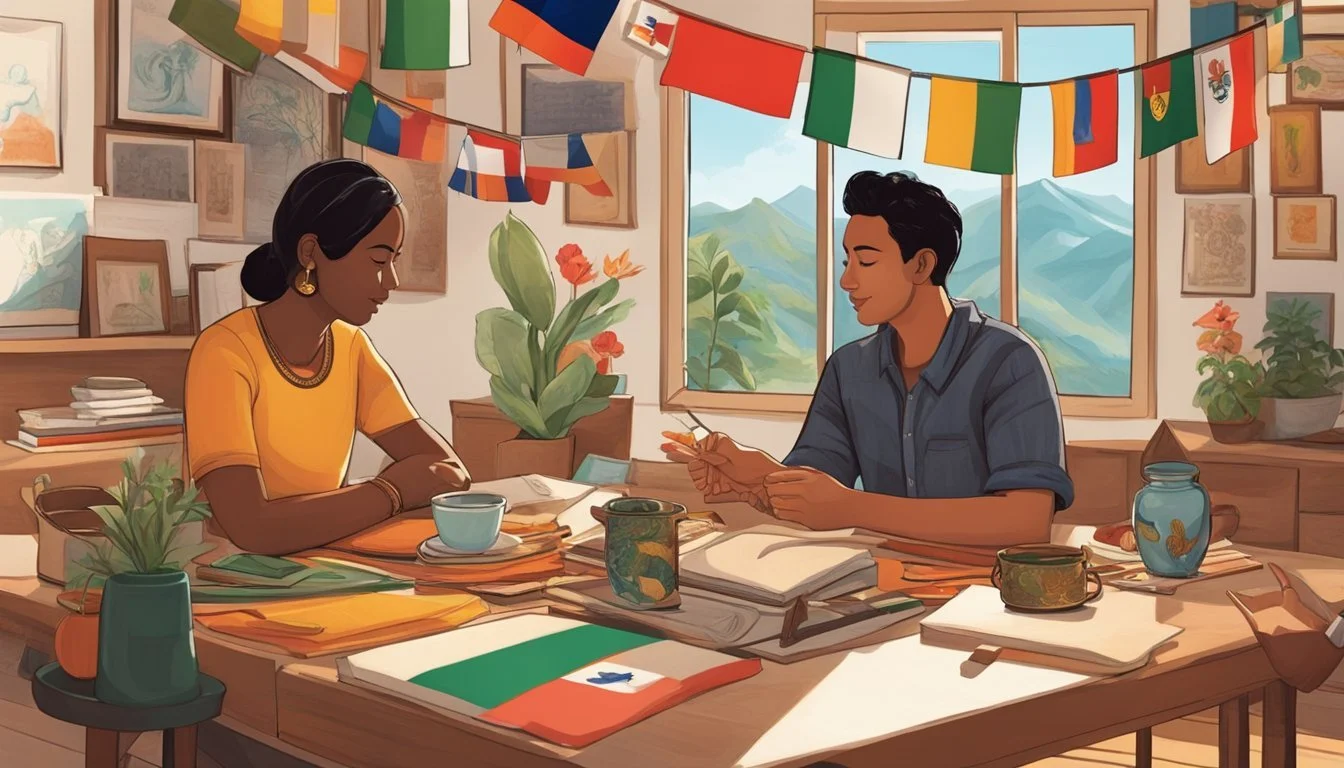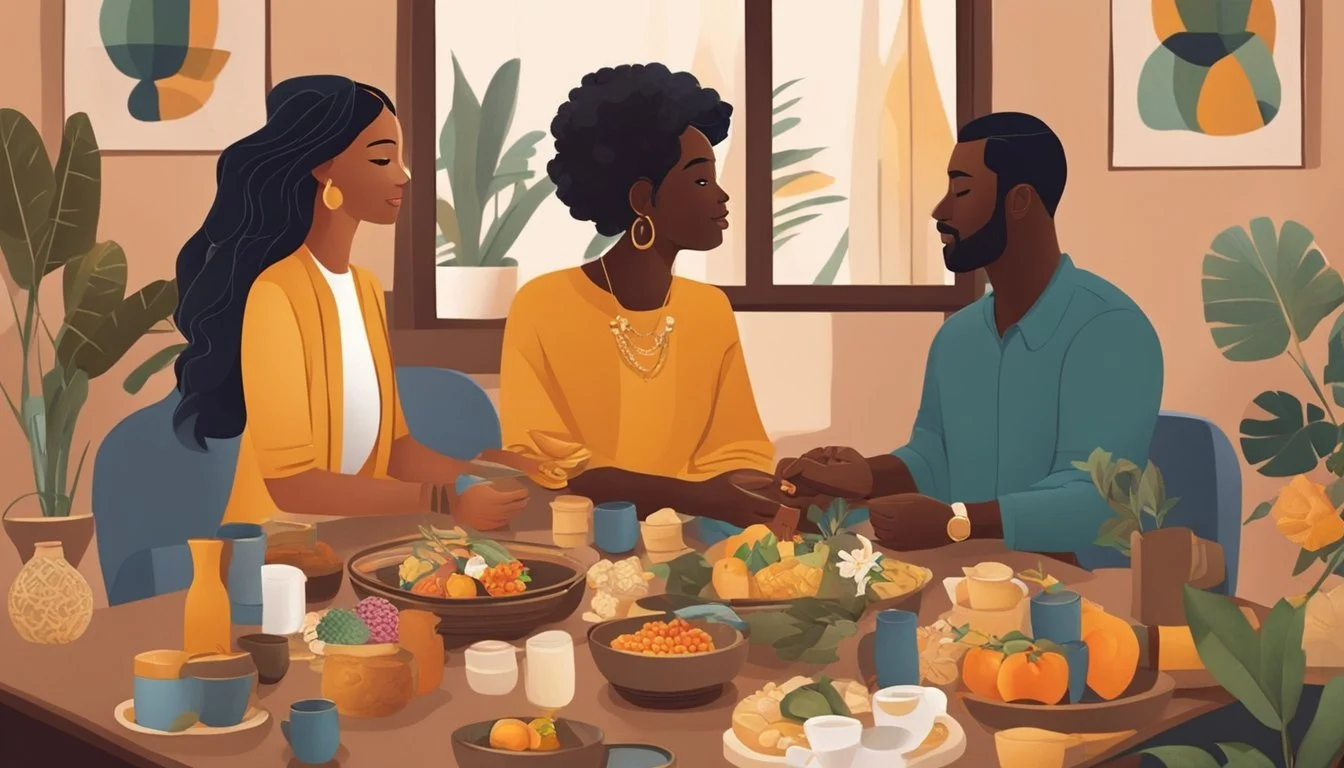8 Tips for Navigating the Challenges of a Multicultural Relationship Effectively
Navigating the complexities of a multicultural relationship can be both enriching and challenging. Each partner brings unique cultural perspectives, traditions, and values that can enhance their joint experience. Understanding how to effectively manage these differences is key to building a strong, harmonious partnership.
Both partners must commit to embracing each other's cultural backgrounds with openness and curiosity. Differences in communication styles, family expectations, and daily habits can create misunderstandings if not approached thoughtfully. With the right strategies, multicultural couples can turn potential obstacles into opportunities for growth and deeper connection.
1) Communicate Openly
Open communication is essential in a multicultural relationship. Partners need to establish a safe space where they can discuss cultural differences and expectations without fear.
It helps to be respectful and attentive. Each person should listen actively and validate their partner’s experiences and feelings.
Clarity is crucial. Misunderstandings often arise from language barriers or different cultural interpretations. Partners should express themselves clearly and check for understanding.
Using relatable examples or anecdotes can make it easier to explain complex cultural concepts. This helps in bridging gaps and finding common ground.
Encouraging honest conversations about traditions, values, and expectations creates a stronger bond. This practice fosters mutual respect and enhances emotional connection.
Maintaining an open mindset is also beneficial. Couples should be willing to learn and adapt to each other's cultural norms.
For further insights on fostering communication in multicultural settings, strategies like open and respectful communication have proven effective.
In conclusion, open communication forms the bedrock of any successful multicultural relationship.
2) Respect Each Other's Cultures
Respecting each other’s cultures in a multicultural relationship is fundamental. Start by acknowledging and valuing the cultural backgrounds and beliefs of both partners.
This may involve learning about each other’s traditions, holidays, and customs. Celebrating these differences together can strengthen the bond and deepen mutual respect.
Open communication is key. Discuss any cultural practices that are particularly important and how they can be integrated into daily life. This helps avoid potential misunderstandings.
Be mindful of cultural sensitivities. This means being cautious with jokes or remarks that could be deemed offensive. Understanding these boundaries is essential for fostering respect.
Incorporating each other’s cultural values into the relationship where possible shows genuine respect and appreciation. This can include adopting certain cultural habits or practices.
When disagreements arise, approach them with an open mind and a willingness to understand the other person’s perspective. This ensures that cultural differences become a point of connection rather than conflict.
Seeking advice from a therapist experienced in multicultural relationships can also be beneficial. They can offer strategies to help navigate cultural differences effectively. For more tips on maintaining strong multicultural relationships, visit Love Across Cultures.
Building a successful multicultural relationship requires continuous effort, understanding, and respect. With the right approach, it can be a deeply enriching experience for both partners.
3) Learn Key Phrases in Each Other's Language
Learning key phrases in each other's language can significantly bridge communication gaps in a multicultural relationship. Simple expressions such as greetings, compliments, and basic questions can show effort and respect for your partner’s culture.
Knowing how to say "hello," "thank you," or "I love you" in your partner's language can create a deeper emotional connection. It demonstrates a willingness to understand and integrate aspects of their culture into your daily life.
Communicating using familiar phrases can also result in smoother interactions during social gatherings with family and friends. It shows a sign of goodwill and helps reduce any awkwardness or miscommunication.
Additionally, learning key phrases can be a fun and engaging activity for both partners. It promotes bonding and can add an element of playfulness to the relationship as each person tries to master the other’s language nuances.
Using language apps or attending language classes together is a productive way to improve language skills. It provides structured learning and exposes both partners to better communication techniques.
Lastly, even though perfection is not required, making an effort to pronounce words correctly can enhance mutual respect and understanding. It acknowledges the importance of the other’s cultural identity and fosters a cooperative and loving environment.
4) Celebrate Cultural Festivals Together
Celebrating cultural festivals is an enriching way to embrace each other's backgrounds. Festivals can bridge gaps between different communities, fostering understanding and respect. Participating in each other's celebrations can strengthen the bond in a multicultural relationship.
Experiencing diverse traditions helps in appreciating your partner’s cultural heritage. Events like the Lunar New Year and Diwali showcase traditions that are significant to many communities. Sharing these experiences can create lasting memories.
Active participation shows support and interest in your partner's culture. It can also provide a learning opportunity for both individuals to explore different customs and festivities. This involvement reflects a willingness to blend traditions and values.
In multicultural relationships, celebrating festivals together can aid in forming a shared identity. It encourages inclusivity and can be a fun way to learn about each other's customs. Moreover, it helps in breaking down barriers and building mutual respect.
Collaborating in festival preparations can enhance teamwork and communication. Preparing traditional dishes, participating in cultural rituals, or even just attending the festivities can be a fulfilling experience. This participation not only celebrates diversity but strengthens the connection between partners.
5) Be Patient and Understanding
Building a successful multicultural relationship takes time and effort. Patience becomes essential as both partners navigate different cultural backgrounds and expectations.
Understanding each other’s perspectives can help bridge cultural gaps. Patience allows for the development of mutual respect and comprehension.
One effective approach is to communicate openly about cultural differences. This can prevent misunderstandings and foster a deeper connection.
Give yourselves the time needed to adjust to one another’s customs and traditions. Rushing the process can lead to frustration and conflict.
Practice active listening, ensuring that both voices are heard. This helps to acknowledge and validate feelings and experiences.
Learning to compromise is also vital. Finding common ground can create a harmonious relationship environment.
Patience and understanding build trust and intimacy. These qualities pave the way for a supportive and loving partnership.
Encouraging each other to explore and appreciate each other’s cultures can further strengthen the bond. This mutual exploration can be a joyful and enriching experience.
6) Avoid Stereotypes
Avoiding stereotypes is crucial in any multicultural relationship. Stereotypes can lead to misunderstandings and can damage trust between partners.
Recognize that everyone is an individual. Generalizing based on someone’s cultural background can prevent you from seeing them for who they truly are.
Be open to learning about your partner’s culture. This shows respect and reduces the tendency to rely on simplistic, stereotypical views.
Listen to your partner’s experiences and perspectives. This helps to understand their unique background and viewpoints, rather than relying on societal assumptions.
Challenge your own biases. Examine preconceived notions you might have and be willing to change them when interacting with your partner.
When you notice a stereotype, address it. Open discussions about these issues can help both partners grow and develop a deeper connection.
For further reading on building cross-cultural relationships, refer to Eight Tips for Building Cross-Cultural Relationships.
7) Seek Common Ground
Finding common ground is essential in multicultural relationships. It involves identifying shared interests, values, and goals that both partners can connect with. By focusing on commonalities, couples can build a solid foundation that transcends cultural differences.
One effective strategy is to engage in activities that both partners enjoy. Whether it’s cooking, traveling, or a shared hobby, participating in these activities together strengthens the bond.
Open communication plays a critical role. Partners should discuss their backgrounds, traditions, and beliefs openly to discover mutual values. This dialogue helps in recognizing and appreciating the similarities.
Establishing shared goals is another key aspect. Whether it’s planning a future together, raising children, or career aspirations, aligning on what matters most ensures both partners are moving in the same direction.
Additionally, celebrating each other’s cultural traditions can enrich the relationship. By embracing and participating in each other's cultural practices, couples not only find common ground but also deepen their connection and understanding.
Addressing family dynamics is also important. Discussing and finding common approaches to familial expectations can help in blending both cultures smoothly. For example, learning about each other’s family customs can aid in harmonizing these differences.
8) Educate Yourself About Each Other's Backgrounds
Understanding each other's backgrounds is crucial in a multicultural relationship. It helps to foster a deeper connection and minimizes misunderstandings.
Learning about your partner’s cultural heritage, traditions, and customs can be enlightening. This knowledge can provide valuable insights into their values and beliefs.
Take the time to ask questions and actively listen when your partner shares stories about their upbringing. This shows genuine interest and respect.
Additionally, reading books, watching documentaries, or attending cultural events together can be beneficial. It provides a broader perspective and enhances mutual appreciation.
Familiarize yourself with important holidays and rituals from your partner’s culture. Celebrating these traditions together strengthens your bond.
Remember that language can be a significant aspect of one’s cultural identity. Trying to learn a few phrases in your partner’s language can be a meaningful gesture.
Engage with their family and community when possible. This first-hand exposure can deepen your understanding and acceptance of each other’s backgrounds.
By educating yourself about your partner’s cultural heritage, you contribute to a more harmonious and respectful relationship. Missteps are natural, but a willingness to learn and adapt can make a significant difference.
Understanding Multicultural Relationships
Multicultural relationships bring together diverse cultural backgrounds, creating both enriching experiences and unique challenges. Grasping the definition and significance of these relationships and addressing common misconceptions is crucial for thriving.
Definition and Importance
A multicultural relationship involves partners from different cultural contexts coming together. These relationships reflect the growing interconnectivity of today's world, where individuals often cross traditional cultural boundaries to form meaningful connections.
The importance lies in the enrichment gained through shared experiences and diverse perspectives.
Furthermore, these relationships can lead to personal growth by fostering empathy, understanding, and adaptability. Couples can build a stronger bond through mutual respect and open-mindedness, turning cultural differences into strengths.
Common Misconceptions
Several misconceptions about multicultural relationships can impede their success. One is the belief that cultural differences automatically lead to conflicts. While challenges exist, adaptability and open communication can mitigate misunderstandings.
Another misconception is that one partner must assimilate into the other's culture entirely. In reality, successful couples find a balance that respects both cultures, creating a unique blend.
There's also the assumption that societal acceptance is universal. Couples may face biases or prejudice, requiring a united front and support from understanding communities.
Understanding these misconceptions can help in navigating a multicultural relationship more effectively. For more detailed insights, visit this guide on multicultural differences in partnerships.
Communication Strategies
Navigating the intricacies of communication in a multicultural relationship involves overcoming language barriers and understanding nonverbal cues. Each is vital for fostering a deep connection and preventing misunderstandings.
Language Barriers
Language differences can pose a significant challenge. It is essential to prioritize clear and simple language, avoiding slang and idiomatic expressions that may not translate well. Using tools like translation apps or language classes can aid in bridging the gap.
Regular practice improves fluency and comprehension. Partners should establish a routine for language learning, dedicating time to practice speaking and listening skills. Even basic proficiency in each other's language shows effort and commitment, which can significantly strengthen the relationship.
It's also helpful to engage in active listening. This involves fully concentrating, understanding, and responding thoughtfully. Clarify misunderstandings immediately by asking follow-up questions or requesting repetition. Using visual aids and gestures can further enhance understanding.
Nonverbal Communication
Nonverbal cues play a crucial role in any relationship, and they are particularly important when verbal communication is limited. Facial expressions, gestures, and body language can convey emotions and intentions more effectively than words at times. Being aware of these can help decode your partner's feelings and reactions.
Cultural variations can impact nonverbal communication. For example, eye contact and personal space norms differ across cultures. It’s important to learn and respect these differences to avoid misinterpretations.
Touch can also vary significantly between cultures—what is comforting in one culture might be intrusive in another. Discuss preferences and boundaries openly.
Additionally, maintaining an open posture and using visual aids like pictures or diagrams can enhance communication. Paying attention to nonverbal signals can lead to a deeper understanding and connection.
Cultural Awareness and Sensitivity
Cultural awareness and sensitivity are vital for building strong and respectful relationships in a multicultural setting. These practices ensure effective communication and foster mutual respect by recognizing and valuing differences.
Recognizing Cultural Norms
Understanding cultural norms is essential in navigating a multicultural relationship. Each culture has unique ways of expressing emotions, greeting others, and showing respect.
For example, some cultures emphasize nonverbal cues over direct communication. This can include facial expressions, body language, and eye contact. Misinterpreting these cues can lead to misunderstandings. Therefore, learning these subtle differences can prevent potential conflicts.
Moreover, various cultures have distinct norms for personal space and physical touch. In some, close physical proximity may be a sign of trust, while in others, it might be inappropriate. Recognizing and adapting to these practices demonstrates respect and fosters harmony.
Respecting Traditions and Customs
Respecting traditions and customs is a cornerstone of cultural sensitivity. Many cultures celebrate specific holidays, dietary restrictions, and unique ceremonies that are integral to their identity.
Participation and acknowledgment of these customs can significantly enhance mutual respect. For instance, understanding dietary restrictions due to religious or cultural practices, like avoiding pork in many Islamic and Jewish traditions, shows thoughtful consideration.
In addition, observing important cultural celebrations like Chinese New Year, Diwali, or Ramadan with your partner can deepen the relationship. It illustrates a willingness to embrace and appreciate their heritage.
By valuing and observing these traditions, individuals not only honor their partner’s culture but also build a foundation of trust and respect in their relationship.
Promotion of effective communication is one of the key benefits of understanding and respecting cultural traditions and customs.







